Zhangming Chan
See Beyond a Single View: Multi-Attribution Learning Leads to Better Conversion Rate Prediction
Aug 21, 2025Abstract:Conversion rate (CVR) prediction is a core component of online advertising systems, where the attribution mechanisms-rules for allocating conversion credit across user touchpoints-fundamentally determine label generation and model optimization. While many industrial platforms support diverse attribution mechanisms (e.g., First-Click, Last-Click, Linear, and Data-Driven Multi-Touch Attribution), conventional approaches restrict model training to labels from a single production-critical attribution mechanism, discarding complementary signals in alternative attribution perspectives. To address this limitation, we propose a novel Multi-Attribution Learning (MAL) framework for CVR prediction that integrates signals from multiple attribution perspectives to better capture the underlying patterns driving user conversions. Specifically, MAL is a joint learning framework consisting of two core components: the Attribution Knowledge Aggregator (AKA) and the Primary Target Predictor (PTP). AKA is implemented as a multi-task learner that integrates knowledge extracted from diverse attribution labels. PTP, in contrast, focuses on the task of generating well-calibrated conversion probabilities that align with the system-optimized attribution metric (e.g., CVR under the Last-Click attribution), ensuring direct compatibility with industrial deployment requirements. Additionally, we propose CAT, a novel training strategy that leverages the Cartesian product of all attribution label combinations to generate enriched supervision signals. This design substantially enhances the performance of the attribution knowledge aggregator. Empirical evaluations demonstrate the superiority of MAL over single-attribution learning baselines, achieving +0.51% GAUC improvement on offline metrics. Online experiments demonstrate that MAL achieved a +2.6% increase in ROI (Return on Investment).
Stick to Facts: Towards Fidelity-oriented Product Description Generation
Mar 12, 2025Abstract:Different from other text generation tasks, in product description generation, it is of vital importance to generate faithful descriptions that stick to the product attribute information. However, little attention has been paid to this problem. To bridge this gap, we propose a model named Fidelity-oriented Product Description Generator (FPDG). FPDG takes the entity label of each word into account, since the product attribute information is always conveyed by entity words. Specifically, we first propose a Recurrent Neural Network (RNN) decoder based on the Entity-label-guided Long Short-Term Memory (ELSTM) cell, taking both the embedding and the entity label of each word as input. Second, we establish a keyword memory that stores the entity labels as keys and keywords as values, allowing FPDG to attend to keywords by attending to their entity labels. Experiments conducted on a large-scale real-world product description dataset show that our model achieves state-of-the-art performance in terms of both traditional generation metrics and human evaluations. Specifically, FPDG increases the fidelity of the generated descriptions by 25%.
Enhancing Taobao Display Advertising with Multimodal Representations: Challenges, Approaches and Insights
Jul 28, 2024



Abstract:Despite the recognized potential of multimodal data to improve model accuracy, many large-scale industrial recommendation systems, including Taobao display advertising system, predominantly depend on sparse ID features in their models. In this work, we explore approaches to leverage multimodal data to enhance the recommendation accuracy. We start from identifying the key challenges in adopting multimodal data in a manner that is both effective and cost-efficient for industrial systems. To address these challenges, we introduce a two-phase framework, including: 1) the pre-training of multimodal representations to capture semantic similarity, and 2) the integration of these representations with existing ID-based models. Furthermore, we detail the architecture of our production system, which is designed to facilitate the deployment of multimodal representations. Since the integration of multimodal representations in mid-2023, we have observed significant performance improvements in Taobao display advertising system. We believe that the insights we have gathered will serve as a valuable resource for practitioners seeking to leverage multimodal data in their systems.
Capturing Conversion Rate Fluctuation during Sales Promotions: A Novel Historical Data Reuse Approach
May 22, 2023



Abstract:Conversion rate (CVR) prediction is one of the core components in online recommender systems, and various approaches have been proposed to obtain accurate and well-calibrated CVR estimation. However, we observe that a well-trained CVR prediction model often performs sub-optimally during sales promotions. This can be largely ascribed to the problem of the data distribution shift, in which the conventional methods no longer work. To this end, we seek to develop alternative modeling techniques for CVR prediction. Observing similar purchase patterns across different promotions, we propose reusing the historical promotion data to capture the promotional conversion patterns. Herein, we propose a novel \textbf{H}istorical \textbf{D}ata \textbf{R}euse (\textbf{HDR}) approach that first retrieves historically similar promotion data and then fine-tunes the CVR prediction model with the acquired data for better adaptation to the promotion mode. HDR consists of three components: an automated data retrieval module that seeks similar data from historical promotions, a distribution shift correction module that re-weights the retrieved data for better aligning with the target promotion, and a TransBlock module that quickly fine-tunes the original model for better adaptation to the promotion mode. Experiments conducted with real-world data demonstrate the effectiveness of HDR, as it improves both ranking and calibration metrics to a large extent. HDR has also been deployed on the display advertising system in Alibaba, bringing a lift of $9\%$ RPM and $16\%$ CVR during Double 11 Sales in 2022.
Follow the Timeline! Generating Abstractive and Extractive Timeline Summary in Chronological Order
Jan 02, 2023Abstract:Nowadays, time-stamped web documents related to a general news query floods spread throughout the Internet, and timeline summarization targets concisely summarizing the evolution trajectory of events along the timeline. Unlike traditional document summarization, timeline summarization needs to model the time series information of the input events and summarize important events in chronological order. To tackle this challenge, in this paper, we propose a Unified Timeline Summarizer (UTS) that can generate abstractive and extractive timeline summaries in time order. Concretely, in the encoder part, we propose a graph-based event encoder that relates multiple events according to their content dependency and learns a global representation of each event. In the decoder part, to ensure the chronological order of the abstractive summary, we propose to extract the feature of event-level attention in its generation process with sequential information remained and use it to simulate the evolutionary attention of the ground truth summary. The event-level attention can also be used to assist in extracting summary, where the extracted summary also comes in time sequence. We augment the previous Chinese large-scale timeline summarization dataset and collect a new English timeline dataset. Extensive experiments conducted on these datasets and on the out-of-domain Timeline 17 dataset show that UTS achieves state-of-the-art performance in terms of both automatic and human evaluations.
KEEP: An Industrial Pre-Training Framework for Online Recommendation via Knowledge Extraction and Plugging
Aug 22, 2022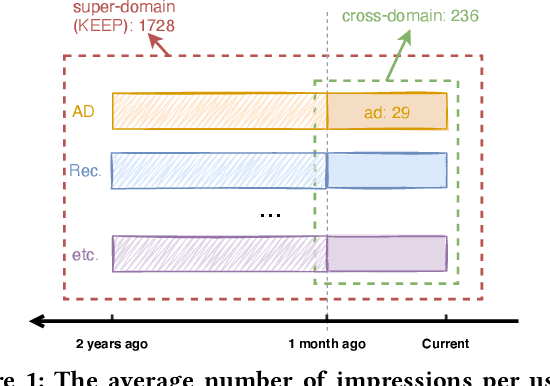

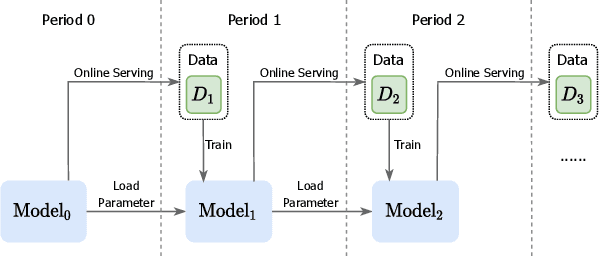
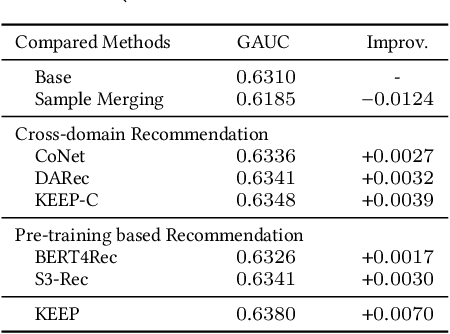
Abstract:An industrial recommender system generally presents a hybrid list that contains results from multiple subsystems. In practice, each subsystem is optimized with its own feedback data to avoid the disturbance among different subsystems. However, we argue that such data usage may lead to sub-optimal online performance because of the \textit{data sparsity}. To alleviate this issue, we propose to extract knowledge from the \textit{super-domain} that contains web-scale and long-time impression data, and further assist the online recommendation task (downstream task). To this end, we propose a novel industrial \textbf{K}nowl\textbf{E}dge \textbf{E}xtraction and \textbf{P}lugging (\textbf{KEEP}) framework, which is a two-stage framework that consists of 1) a supervised pre-training knowledge extraction module on super-domain, and 2) a plug-in network that incorporates the extracted knowledge into the downstream model. This makes it friendly for incremental training of online recommendation. Moreover, we design an efficient empirical approach for KEEP and introduce our hands-on experience during the implementation of KEEP in a large-scale industrial system. Experiments conducted on two real-world datasets demonstrate that KEEP can achieve promising results. It is notable that KEEP has also been deployed on the display advertising system in Alibaba, bringing a lift of $+5.4\%$ CTR and $+4.7\%$ RPM.
Adversarial Gradient Driven Exploration for Deep Click-Through Rate Prediction
Dec 21, 2021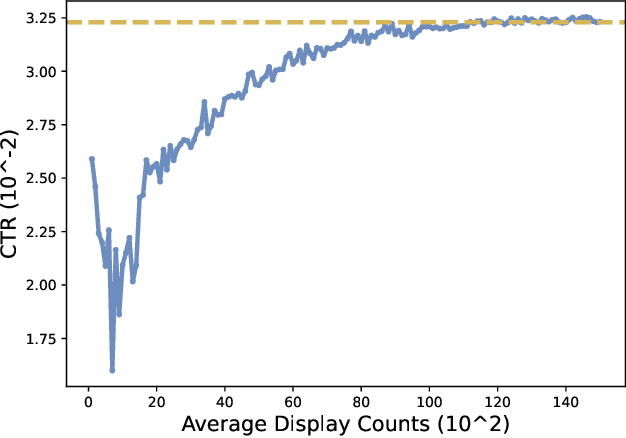
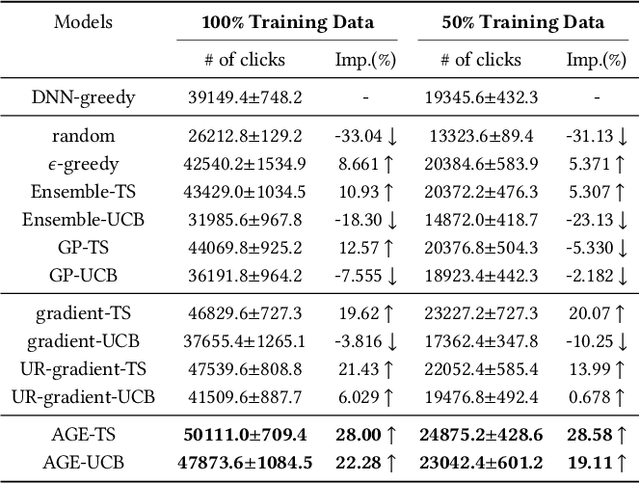
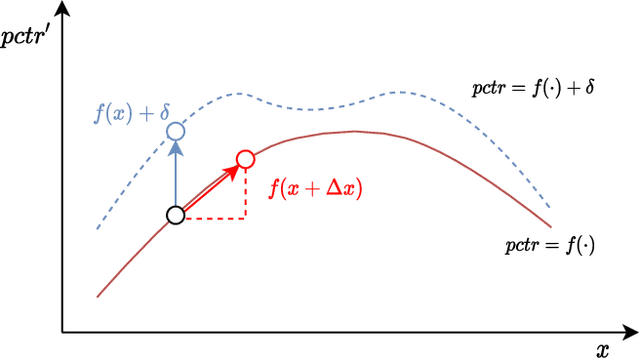
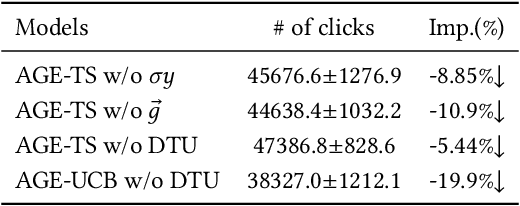
Abstract:Nowadays, data-driven deep neural models have already shown remarkable progress on Click-through Rate (CTR) prediction. Unfortunately, the effectiveness of such models may fail when there are insufficient data. To handle this issue, researchers often adopt exploration strategies to examine items based on the estimated reward, e.g., UCB or Thompson Sampling. In the context of Exploitation-and-Exploration for CTR prediction, recent studies have attempted to utilize the prediction uncertainty along with model prediction as the reward score. However, we argue that such an approach may make the final ranking score deviate from the original distribution, and thereby affect model performance in the online system. In this paper, we propose a novel exploration method called \textbf{A}dversarial \textbf{G}radient Driven \textbf{E}xploration (AGE). Specifically, we propose a Pseudo-Exploration Module to simulate the gradient updating process, which can approximate the influence of the samples of to-be-explored items for the model. In addition, for better exploration efficiency, we propose an Dynamic Threshold Unit to eliminate the effects of those samples with low potential CTR. The effectiveness of our approach was demonstrated on an open-access academic dataset. Meanwhile, AGE has also been deployed in a real-world display advertising platform and all online metrics have been significantly improved.
Dialogue History Matters! Personalized Response Selectionin Multi-turn Retrieval-based Chatbots
Mar 17, 2021



Abstract:Existing multi-turn context-response matching methods mainly concentrate on obtaining multi-level and multi-dimension representations and better interactions between context utterances and response. However, in real-place conversation scenarios, whether a response candidate is suitable not only counts on the given dialogue context but also other backgrounds, e.g., wording habits, user-specific dialogue history content. To fill the gap between these up-to-date methods and the real-world applications, we incorporate user-specific dialogue history into the response selection and propose a personalized hybrid matching network (PHMN). Our contributions are two-fold: 1) our model extracts personalized wording behaviors from user-specific dialogue history as extra matching information; 2) we perform hybrid representation learning on context-response utterances and explicitly incorporate a customized attention mechanism to extract vital information from context-response interactions so as to improve the accuracy of matching. We evaluate our model on two large datasets with user identification, i.e., personalized Ubuntu dialogue Corpus (P-Ubuntu) and personalized Weibo dataset (P-Weibo). Experimental results confirm that our method significantly outperforms several strong models by combining personalized attention, wording behaviors, and hybrid representation learning.
VMSMO: Learning to Generate Multimodal Summary for Video-based News Articles
Oct 12, 2020



Abstract:A popular multimedia news format nowadays is providing users with a lively video and a corresponding news article, which is employed by influential news media including CNN, BBC, and social media including Twitter and Weibo. In such a case, automatically choosing a proper cover frame of the video and generating an appropriate textual summary of the article can help editors save time, and readers make the decision more effectively. Hence, in this paper, we propose the task of Video-based Multimodal Summarization with Multimodal Output (VMSMO) to tackle such a problem. The main challenge in this task is to jointly model the temporal dependency of video with semantic meaning of article. To this end, we propose a Dual-Interaction-based Multimodal Summarizer (DIMS), consisting of a dual interaction module and multimodal generator. In the dual interaction module, we propose a conditional self-attention mechanism that captures local semantic information within video and a global-attention mechanism that handles the semantic relationship between news text and video from a high level. Extensive experiments conducted on a large-scale real-world VMSMO dataset show that DIMS achieves the state-of-the-art performance in terms of both automatic metrics and human evaluations.
How to Write Summaries with Patterns? Learning towards Abstractive Summarization through Prototype Editing
Sep 19, 2019



Abstract:Under special circumstances, summaries should conform to a particular style with patterns, such as court judgments and abstracts in academic papers. To this end, the prototype document-summary pairs can be utilized to generate better summaries. There are two main challenges in this task: (1) the model needs to incorporate learned patterns from the prototype, but (2) should avoid copying contents other than the patternized words---such as irrelevant facts---into the generated summaries. To tackle these challenges, we design a model named Prototype Editing based Summary Generator (PESG). PESG first learns summary patterns and prototype facts by analyzing the correlation between a prototype document and its summary. Prototype facts are then utilized to help extract facts from the input document. Next, an editing generator generates new summary based on the summary pattern or extracted facts. Finally, to address the second challenge, a fact checker is used to estimate mutual information between the input document and generated summary, providing an additional signal for the generator. Extensive experiments conducted on a large-scale real-world text summarization dataset show that PESG achieves the state-of-the-art performance in terms of both automatic metrics and human evaluations.
 Add to Chrome
Add to Chrome Add to Firefox
Add to Firefox Add to Edge
Add to Edge